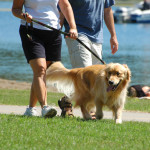Walking 101

My two children began walking long before their first birthdays. I never had to teach them how to put one foot in front of the other; they just did what came naturally to them. As their young bodies matured, their wide-stanced feet moved closer together, their arms began to swing near their sides, and they strode forward with a smooth pattern of movement.
Somewhere along the way, however, we adults can actually “forget” how to walk the right way—typically because we’ve lost some flexibility or strength, or due to an injury we’ve suffered along the way.
How you walk effects the wear pattern of your feet, ankles, knees, hips, and spine. Surprisingly, something as seemingly insignificant as ankle stiffness can wind up generating low back pain years down the line!
Here are the top three “gait offenders” I repeatedly treat in my physical therapy practice. Could your body could use some “re-schooling” in one of these areas?
#1—Lack of Heel Strike: Each step you take should begin with a distinct “touch down” of your heel. Once your heel hits the ground, your weight bearing should progress forward through your mid-foot and then through the “ball of your foot” before finally passing through your toes. Go on; practice this sequence to improve your efficiency and fluidity.
#2—Tight Calf Muscles: A tight calf muscle, or two, will not allow your ankle(s) to bend fully. This ankle limitation will leave you with a shorter stride (or step) length on the opposite side of the shortened calf muscle—or on both sides if both your calves are tight. Your body will try to compensate for this limited step length by excessively (and ultimately destructive) arching your lower back. Regular stretching these key gait muscles will go a long way towards protecting your spine while you walk*.
#3—Weak Lateral Hip Muscles: If your upper body rocks to one or both sides when you walk, or if your back, buttock(s), or hip(s) aches after you’ve been walking awhile, it’s likely you have weakness of your gluteus medius muscle(s). This critically import gait muscle is located on both sides of your pelvis. If you work to improve the strength and endurance of this muscle, the rest of your body will smile*.
*Check out my book, Get Healthy for Heaven’s Sake’s, the 10-Minute Muscle Makeover chapter, for great photo illustrations of both of these vital exercises—or search for these exercises online.